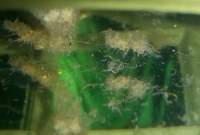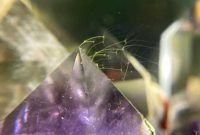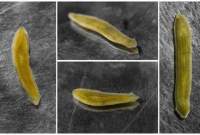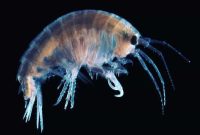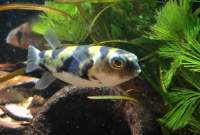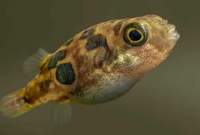There is no guarantee that your tank will always stay stable and healthy without getting affected by any problems at all. Every fish tank definitely has experience with a problem; algae are a common issue that appears in the aquariums, which can destroy the ecosystem inside. At least, you will see a few small clusters of algae grow at several points.
Good news, if you keep some platyfish in your planted aquarium, they are not picky eater animals; without mind the appearance of algae, these fish without hesitation, will eat them.
Most algae varieties are not damaged to platy and other fish, but too much population of them would crash the balance of the ecosystem; the plants will lack nutrients, light, and nutrients, as well as lacking dissolved oxygen making the fish suffocate.
Today, let us recognize more profound about the platies and any facts that relate to this small adorable fish with algae in the aquarium.
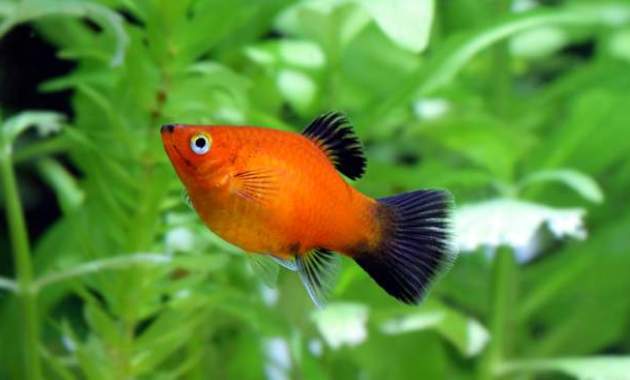
TABLE OF CONTENTS
What Are Platies?
Platy is fish part of a tropical fish member that belongs to the family Poeciliidae, under the Xiphophorus genus. Platies are also called common platy, southern platyfish, and moonfish. They are closely related to their cousin, the green swordtail (Xiphophorus hellerii), that can interbreed with them.
These small freshwater fish species originate from the east coast of Central America (Nicaragua, Guatemala, Belize) and southern Mexico. Most populations are usually found occupying some water bodies, including ponds, backwater, ditches, swamps, and flooded pastures.
There are two most species that are sold in the aquarium trades, platy fish (Xiphophorus maculatus) and variable platy fish (Xiphophorus variatus). They frequently crossbreed each other or even with swordtail species in the captivities. It makes their appearance more interesting rather than wild platy fish types, which are usually less colorful and unattractive.
How big do platys get? On average, the males are commonly around 2 inches, and females may reach up to 3 inches in length. While the variable platy variety is slightly larger than common southern platies.
Their body size is the main sign to identify between males and females of platy fish; besides that, the females have a gonopodium.
Platies are tiny fish that only have a 10-gallon tank to accommodate a group that contains from 5-6 individuals. Well, if you have a 20-gallon tank at house, it is more than enough to cover 10 platyfish. They might not be schooling fish species; however, keeping them in a group that consists of at least 6 individuals is more preferred by them.
The platys fish from captivity generally have an average lifespan of about 2 – 3 years. In their habitat, the wild platies can live longer than it. Under an optimal tank environment and proper care will allow these fish to thrive well with high life expectancy rates.
Platies are relatively cheap; a healthy adult fish normally cost between $3-$6. But, if you purchase them in a group that commonly consists of 5 or more, you probably get a good price rather than one.
What Do Platy Fish Eat?
In nature, they accept most food types, including tiny insects, small crustaceans, plant matter, and algae. While in the aquarium habitat, they can eat various food, such as bloodworm, tubifex worm, brine shrimps, blanched spinach, cucumbers, lettuce, and some commercial food such as flakes, spirulina tabs, or even floating pellets that made up for betta fish and goldfish.
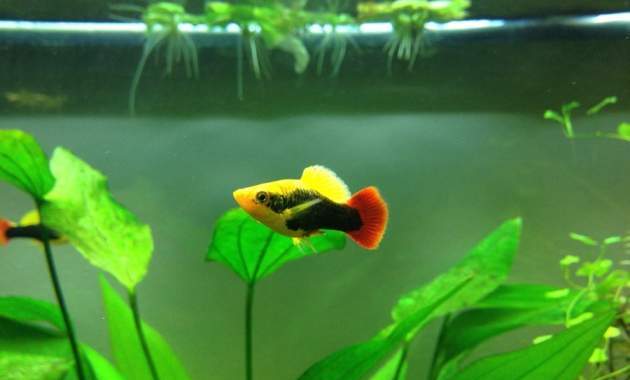
Buy Platies Fish Only On Amazon
Do Platies Eat Your Aquarium Plants?
In some cases, platies might munch your aquatic plants, especially the gentle ones like marimo moss, hygrophila, duckweed, ambulia, egeria, myriophyllum, aponogeton, rotala, nymphea, water sprite, riccia, and cabomba. The ticker and robust aquascape plants type usually do not get any nibble from them. In fact, they prefer to eat the younger leaves and dead plants. However, platies do not eat plant parts too much. They nip on it when these fish want, usually to get extra energy.
So, do not worry about keeping platies inside your planted tank. They would not consume your beloved aquatic plants completely; the small nibble from platy typically does not hurt them seriously.
Are Aquarium Algae Good For Platies?
As mentioned above, algae are one of the primary platies’ food in the wild. Of course, the aquarium algae also give many benefits for the platys. The adults, young, and fry platy fish eat algae in the aquarium, although in different portions. When another food is hard to find in the aquarium, platies will happily chew the algae that grow on the surface of plants for a whole day.
However, the best food for platy fish is the live types such as mosquito larvae. It contains high nutrients than most types of alga. At least the presence of algae in the aquascape tank will load their hungry stomach.
Can Platies Become An Excellent Algae Eater?
Platy fish is not a member of the family of true algae eaters, but they can eat algae. They are probably effective in cleaning low algae outbreak levels but did not work for an advanced level. Platies only feed on certain aquarium algae types.
So, relying on platies fish to remove algae populations is not recommended; they should be partnered with real algae eaters such as otocinclus.
For your information, the common platies (Xiphophorus maculatus) eat fewer algae than variable platies (Xiphophorus variatus).
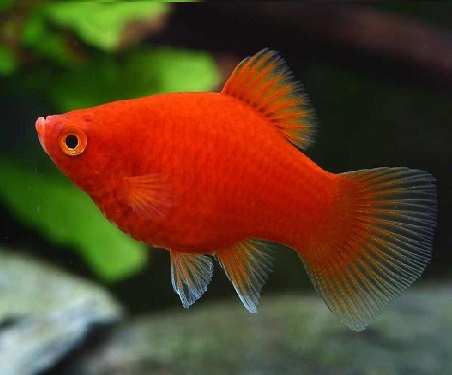
What Kind Of Algae Types That Platy Fish Feed On?
As we know, there are two main species of common aquarium algae: red algae and green algae. These algae are divided into several subspecies based on their characteristics. Unfortunately, platy fish only consume a few subvarieties with not too many portions. What kind of algae varieties that platies eat? Here is the list.
Do Platies Eat Green Hair Algae?
Green hair algae actually is not an independent species of algae. This is a category of green filamentous algae that has 4 species, that is spirogyra, cladophora, oedogonium, and rhizoclonium.
There are several algae names that are usually used by many aquarists to describe one of those species, including string algae, thread algae, and fuzz algae.
Hair algae contain more nutrients than red algae; they grow rapidly and stick on almost surfaces such as decorations, plants, equipment, substrate, and even as a floating mass on the water surface.
Platies like to nip the young, short green hair algae that thrive on the leaves. In most cases, they often spend much time swimming around this hairy algae and get enough energy by eating them.
Do Platies Eat Staghorn Algae?
As their name, the appearance of these red algae resembles a stag’s horn. They are growing on the substrate, decorations, and aquatic plants.
Most aquarium pets prefer to uncheck this pest from their snack list; it makes the staghorn easily take over your aquarium. Luckily, platyfish is one of the smallest popular freshwater fish that are willing to eat the staghorn algae.
But, sad to say, most platies tend to eat the young and dead staghorn algae, while the adult one is often to be left due to their harsher textures. However, there is always a solution, add some doses of seachem excel straightforward to them until they are melting, then the platies will clean the remains.
Do Platies Eat Black Beard Algae?
Even though BBA belongs to the red algae family, they almost do not have red color at all; instead, their color range from dark green and browny grey to deep black.
They tend to discover attached on rough plants and hard surfaces as slippery and soft beard-like stuff. Black brush algae are one of the stubborn pests, making them harder to eliminate.
Platies are a pretty potent weapon in order to against the black beard algae. Reduce their food portion, kill the BBA with algae removals like API Algaefix, and leave the platy fish to feast.
Do Platies Eat Brown Algae?
If the brown algae thrive in your freshwater tank, it indicates there is an imbalanced aquarium parameter.
Please do not let the platies remove the brown algae alone due to their diet habit and spreading algae speed; it would make your tank be takeover by this plague easily. So, choose the algae eater tankmates that fit your platies fish’s behavior.
Type Of Aquarium Algae That Platies Won’t Eat
It’s all aquarium algae varieties that are loved by platies; now, we will tell some algae types that this animal avoids, so you can prepare the ways to prevent their infestation in your platy fish tank.
Green Spot/Dot Algae
Unlike most algae varieties, these algae do not grow tall; they tend to spread flatted form and are hard to touch. Green spot algae are mostly found to develop on the surface of objects that do not move anywhere, such as driftwood, substrate, rocks, decorations, and aquarium wall glass.
They also love sitting on some slow-growth aquatic plants, which commonly act like dark green spot stuff on leaves. Due to their texture and slightly tricky to nibble, makes they often be left by most platies fish. Some mollusk algae eaters, such as nerite snails, generally can accept them, though does not clean entirely and often abandon irregular patterns on the wall glass.
Green Dust Algae
Sometimes people made be confused between green spot and green dust algae; however, both are very distinct. Green dust algae are safe for aquarium populations, but platy fish tend to avoid them. You need some aquarium snails to wipe them out.
Blue-green Algae
Actually, blue-green algae are bacterial, called cyanobacteria. They usually appear as weird floating green or blue slime in the aquarium. Different from most algae types which frequently grow by attaching to the surfaces, this alga can not be.
You need to realize if the platies fish does not eat blue-green algae because they can be dangerous and toxic for this small aquarium fish.
Green Water
Your planted tank water turns into a green cloud; it might be triggered by some microorganisms called phytoplankton. If you leave them untreated, this green water gets thicker and thicker until unseen anything.
This alga is not harmful to fish and plants. Some may feel happily live in green-colored water in their natural habitat. Their size is very small until you can not see with naked eyes, it makes your platys impossible to eat them.
Red Spot Algae
They become the rarest algae that are present in the aquascaping world. You might hear a little bit of information about this species because they only grow in a particular tank with a specific parameter.
Red spot algae belong to the hildenbrandia genus, grow like green spot algae, and develop in flat shapes over hard surfaces such as on stones and thicker leaves. Platies maybe won’t eat them; red spot algae are frequently found to grow to stick heavily, making them difficult to bite.
Do Platies Eat Algae Wafer?
Wafer algae-based is a commercial food product that is commonly sold in many pet stores and online trades. It is actually made off for bottom dweller fish species such as plecostomus. Platies also gladly nip the spirulina tablets, this product is good for their health which contains high proteins and nutrients.
Do Platies Eat Aquarium Parasites?
The tiny aquatic parasites that often arise in the aquarium, such as hydra, scuds, planaria, and detritus worms, are great diets for platys fish. They have high proteins that are very useful for platies’ growth and body color. This tropical aquarium fish will be excited to hunt them, exploring every corner of the fish tank to find any odd tiny creatures, as mentioned before.
If you left platy to choose between algae and parasites, they would select the parasites cheerfully because the live food is their favorite meal.
Can Platies Live Only By Eating Algae?
If you leave your platy tank for a certain period and algae thrive there, they can still live although without adding any particular fish food. However, this bad practice may starve and suffer your fish; we never suggest anyone perform this.
It also can stimulate the platies to eat your valuable aquatic plants and even their own fry. This is why the owners should ensure the food stock always be available in the aquarium for a whole day.
Can The Real Algae Eaters Keeping Alongside With Platies?
The answer is yes, some truly algae eaters can help the platies in order to remove every algae clump, especially in the middle to high outbreak levels. They will strike the plague swiftly rather than relying on platies to fight alone.
Moreover, in selecting algae eaters species, make sure they have similar characteristics to live peacefully in harmony with platies. Here are some algae eaters tankmates that are suitable for living with platy fish:
- Bulldog plecostomus
- Pitbull pleco
- Otocinclus catfish
- Nerite snails
- Apple snails
- Ramshorn snails
- Rabbit snails
- Malaysian trumpet snails
- Twig catfish
- Hillstream loaches
- Suckermouth catfish
- Whiptail plecos
- Bristlenose pleco fish
- Siamese algae eater fish
- Chinese algae eater fish
- Siamese flying fox
Adding shrimps to platies tank is not recommended, remembering this fish is an omnivore, and small crustaceans family is one of their favorite diets. So, putting some shrimp algae eaters might make them in danger. In this case, the young and shrimplets are prone to predate due to their size, which fits with platy’s mouth.
If no food stock is left, the poor adult shrimps are probably getting nipped by the platies until they surrender.
Do Platies Can Eat Algae In The Saltwater Tank?
In nature, platies do not inhabit brackish water or even seawater at all. Instead, they can be found in highland streams such as mountain rivers. So, it is quite impossible to make them could be adapted to the marine aquarium although throughout the drip acclimation process like mollies and guppies.
However, there is some report on the internet stating that someone has succeeded in transitioning the freshwater platy fish to a saltwater form. However, it still can not be appropriately confirmed. Well, we conclude if the platies can not live in the reef tank to eat the algae there.
Do Platies Can Eat Algae In The Coldwater Tank?
Platies are tropical fish species where the water temperature of their natural habitat is slightly warm; an ideal temperature ranges from about 75 to 80 degrees Fahrenheit or 24 to 28 degrees Celsius.
Anything smaller than this number levels can hurt or even kill your fish. So, do not believe in any information that declares the platies can live and survive in coldwater environments. It means platys do not eat algae in the coldwater aquarium.


